NCERT Solutions for Exercise 9.1 Class 10 Maths Chapter 9 - Some Applications of Trigonometry
CBSE Class 10th Exam Date:01 Jan' 26 - 14 Feb' 26
Trigonometry enables people to determine building heights and river distances through measurements when direct approaches are impossible. The exercise transitions to practical trigonometry, which introduces us to elevation and depression angles. To solve real-life problems, we use triangles for visualisation, so we learn about applying sine, cosine and tangent ratios to obtain unknown heights and distances. The education develops both analytical skills and practical usage abilities.
This Story also Contains
- NCERT Solutions Class 10 Maths Chapter 9: Exercise 9.1
- Access Solution of Some Applications of Trigonometry Class 10 Chapter 9 Exercise: 9.1
- Topics Covered in Chapter 9 Applications of Trigonometry: Exercise 9.1
- NCERT Solutions of Class 10 Subject Wise
- NCERT Exemplar Solutions of Class 10 Subject-Wise
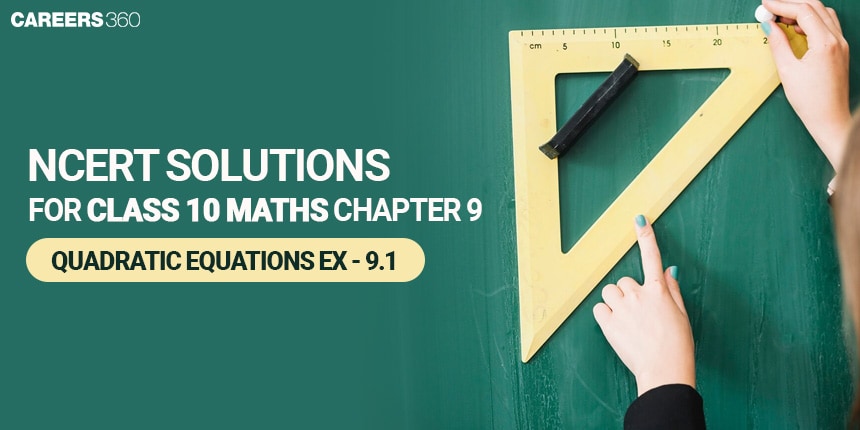
Class 10 students should use the NCERT Solutions to solve real-life right-angled triangle problems with basic trigonometric ratios. The exercise teaches students to recognise appropriate triangles, then select proper trigonometric ratios before correctly solving elevation and depression angle problems. The education provided in the exercises provided in NCERT Books serves essential groundwork for advanced trigonometric applications used in navigation, along with surveying and construction work, and astronomy.
NCERT Solutions Class 10 Maths Chapter 9: Exercise 9.1
Access Solution of Some Applications of Trigonometry Class 10 Chapter 9 Exercise: 9.1
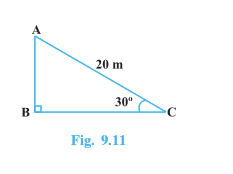
Answer:
Given that,
The length of the rope (AC) = 20 m. and
Let the height of the pole (AB) be
So, in the right triangle

By using the Sin rule
Hence the height of the pole is 10 m.
Answer:
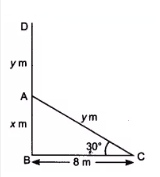
Suppose DB is a tree and the AD is the broken height of the tree which touches the ground at C.
Given that,
let AB =
So, AD+AB = DB =
In right angle triangle
So, the value of
Similarily,
the value of
So, the total height of the tree is-
= 8 (1.732) = 13.856 m (approx)
Answer:
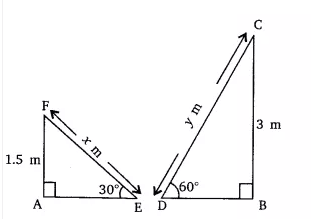
Suppose
Given that,
AF = 1.5 m, BC = 3 m,
In triangle
The value of
Similarily in
the value of
Hence the length of the slide for children below 5 yrs. is 3 m and for the elder children is 3.468 m.
Answer:
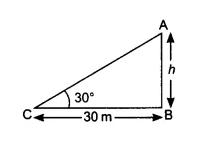
Let the height of the tower AB is
According to question,
In the right triangle
the value of
Thus the height of the tower is 17.32 m
Answer:
A
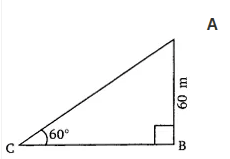
Given that,
The length of AB = 60 m and the inclination of the string with the ground at point C is
Let the length of the string AC be
According to question,
In right triangle
The value of length of the string (
Hence the length of the string is 69.28 m.
Answer:
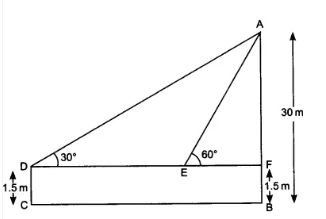
Given that,
The height of the tallboy (DC) is 1.5 m and the height of the building (AB) is 30 m.
According to question,
In right triangle AFD,
So, DF =
In right angle triangle
EF =
So, distance walked by the boy towards the building = DF - EF =
Answer:
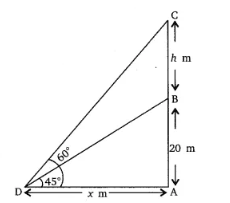
Suppose BC =
We have,
AB = 20 m, BC =
According to question,
In triangle
So,
Again,
In triangle
Answer- the height of the tower is 14.64 m
Answer:
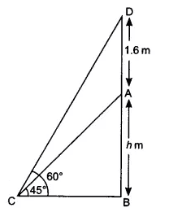
Let the height of the pedestal be
the angle of elevation of the top of the statue and top of the pedestal is(
Now,
In triangle
therefore, BC =
In triangle
the value of
Hence the height of the pedestal is
Answer:
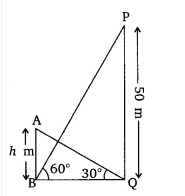
It is given that, the height of the tower (AB) is 50 m.
Let the height of the building be
According to question,
In triangle PBQ,
In triangle ABQ,
On equating the eq(i) and (ii) we get,
therefore,
Answer:
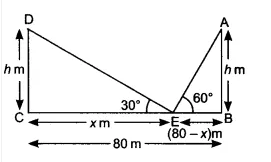
Given that,
The height of both poles are equal DC = AB. The angle of elevation of of the top of the poles are
Let the height of the poles be
According to question,
In triangle DEC,
In triangle AEB,
On equating eq (i) and eq (ii), we get
So,
Hence the height of both poles is (
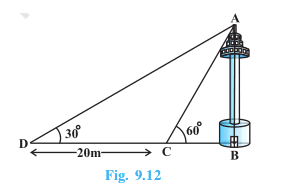
Answer:
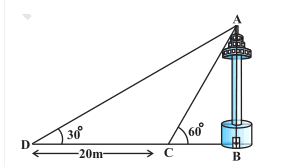
Suppose the
It is given that, the width of CD is 20 m,
According to question,
In triangle
In triangle ACB,
On equating eq (i) and (ii) we get:
from here we can calculate the value of
Answer:
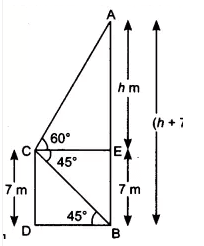
Let the height of the cable tower be (AB =
Given,
The height of the building is 7 m and angle of elevation of the top of the tower
According to question,
In triangle
since DB = CE = 7 m
In triangle
Thus, the total height of the tower equal to
Answer:
Given that,
The height of the lighthouse (AB) is 75 m from the sea level. And the angle of depression of two different ships are
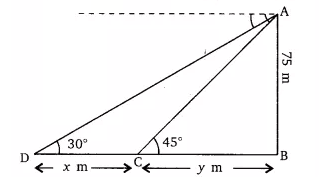
Let the distance between both the ships be
According to question,
In triangle
In triangle
From equation (i) and (ii) we get;
Hence, the distance between the two ships is approx 55 m.
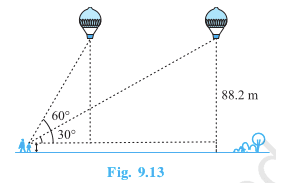
Answer:
Given that,
The height of the girl is 1.2 m. The height of the balloon from the ground is 88.2 m and the angle of elevation of the balloon from the eye of the girl at any instant is (
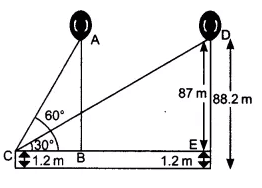
Let the
AB = ED = 88.2 - 1.2 =87 m
Now, In triangle
In triangle
Thus, distance traveled by the balloon from position A to D
Answer:
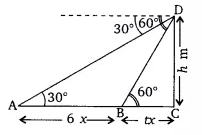
Let
According to question,
In triangle
In triangle
Put the value of
Hence, from point B car take 3 sec to reach the foot of the tower.
Answer:
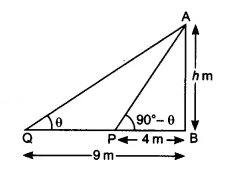
Let the height of the tower be
we have PB = 4m and QB = 9 m
Suppose
According to question,
In triangle
In triangle
multiply the equation (i) and (ii), we get
Hence the height of the tower is 6 m.
Topics Covered in Chapter 9 Applications of Trigonometry: Exercise 9.1
The questions in exercise 9.1 Class 10 Maths broadly consist of some basic questions in which we have to find height and distance with the help of the formulas of tangent, cosine and sine. Some of the terms used in the problems are as follows.
- Line of Sight: It is the line drawn from the eye of an observer to the point in the object viewed by the observer.
- Angle of Elevation: An observer who looks up toward an object will experience this phenomenon. It is the angle formed by the line of sight with the horizontal when the point being viewed is above the horizontal level.
E.g.: Person looking at the top of a tree. - Angle of Depression: An observer who looks down toward an object will experience this phenomenon. It is the angle formed by the line of sight with the horizontal when the point is below the horizontal level.
E.g., standing on a cliff and looking at a boat in the sea.
The following key sequence directs a solution to these problems:
- Spot the right-angled triangle present in the provided problem.
- Identify known along with unknown values of height, distance and angle in this problem.
- Select the appropriate trigonometric ratio according to the available information.
- Solve for the unknown value.
Also see-
NCERT Solutions of Class 10 Subject Wise
Students must check the NCERT solutions for class 10 of the Mathematics and Science Subjects.
NCERT Exemplar Solutions of Class 10 Subject-Wise
Students must check the NCERT Exemplar solutions for class 10 of the Mathematics and Science Subjects.
Frequently Asked Questions (FAQs)
The values of all trigonometric functions dependent on the value of the ratio of sides in a right-angled triangle are known as trigonometric ratios.
angle of depression
angle of elevation
line of sight
finding the height or length of an object or the distance between two distant objects
The angle created by the line of sight with the horizontal when it is above the horizontal level is the angle of elevation of an item that we can see.
When we elevate our head to gaze at an object, for example.
The angle formed by the line of sight with the horizontal when it is below the horizontal level is the angle of depression of an item that we can see.
When we drop our head to gaze at an object, for example.
The line of sight is the line which is a line traced from an observer's eye to a point in the item being seen.
Trigonometric ratios can be used to calculate an object's height or length, as well as the distance between two distant objects.
Before the Class 10 Mathematics chapter 9 activity 9.1, there are seven key questions that must be answered.
In the NCERT solutions for the Class 10 Maths chapter 9 exercise, there are 16 problems.
Questions related to CBSE Class 10th
On Question asked by student community
The CBSE Sahodaya Question Papers for Class 10 (2025-26) are not released centrally by the board as a single PDF.
Here is the essential information you need:
-
Local Release: The papers are designed and released by the individual Sahodaya School Clusters (groups of CBSE schools) just before or during the pre-board exam dates (typically held in December and January). Therefore, you must check your local cluster's portal or directly with your school administration.
-
Best Practice: The official model papers, based on the full 2026 syllabus, are the most reliable tool for practice. These accurately reflect the structure, format, and competency-based questions used in the Sahodaya exams.
You can download the latest CBSE Class 10 Model Papers to simulate the Sahodaya tests here: https://school.careers360.com/articles/sahodaya-question-paper-2025 . Focus on that pattern
Hi! If you’re looking for the Class 11 English half yearly question paper for 2025-26 (CBSE board), you’ll find the right resource once you check the link provided from Careers360. Solving previous or sample papers is a smart way to prepare, as it helps you understand the question types, marking scheme, and important topics. This practice will boost your confidence and help you manage your time well in the actual exam.
https://school.careers360.com/boards/cbse/cbse-class-11-half-yearly-sample-papers-2025-26
Hi dear candidate,
Could you please specify us the board of education for which you need the half yearly question papers of class X so that we can help you further.
Below are few links which may help you and it has all the subjects with English as well:
CBSE Class 10 Half Yearly Exam Question Paper 2025-26 with Answer Key & Analysis
ICSE Class 10 Half Yearly Sample Papers 2025-26 PDF (All Subjects)
BEST REGARDS
Hi dear candidate,
Can you please specify the board of education or state for which you need to know the exam pattern and syllabus so that we can guide you accordingly.
Since, most of the boards uses NCERT as base syllabus, you can refer to the link below:
NCERT Syllabus for Class 10 – All Subjects PDF Download 2025-26
Exam pattern:
CBSE 10th New Exam Pattern 2026- Marking Scheme, Subject-Wise Exam Pattern
BEST REGARDS
The CBSE Class 10th Board Exams for the 2026 session will follow the revised curriculum, emphasizing competency-based questions.
-
Conducting Body: Central Board of Secondary Education (CBSE).
-
Exam Period: The main theory exams are typically held between February and April 2026.
-
Grading: Based on marks in five main subjects plus internal assessment marks (often 20 marks per subject) provided by the school.
-
Passing Criteria: You must achieve at least 33% overall in each subject (theory + practical/internal assessment combined) to be declared pass.
Key Preparation Strategy
The most crucial element of your preparation is understanding the exam structure:
-
Syllabus: Strictly adhere to the rationalized syllabus released by CBSE for the 2025-26 academic year.
-
Practice: Your primary resource should be the latest sample papers and previous year question papers. These accurately reflect the format and types of competency questions being asked.
For the most comprehensive and official announcements, including the detailed time table and access to crucial practice materials, always check the official board updates, as tracked by Careers360: https://school.careers360.com/exams/cbse-class-10th .
Applications for Admissions are open.
As per latest syllabus. Physics formulas, equations, & laws of class 11 & 12th chapters
JEE Main Important Chemistry formulas
Get nowAs per latest syllabus. Chemistry formulas, equations, & laws of class 11 & 12th chapters
JEE Main high scoring chapters and topics
Get nowAs per latest 2024 syllabus. Study 40% syllabus and score upto 100% marks in JEE
JEE Main Important Mathematics Formulas
Get nowAs per latest syllabus. Maths formulas, equations, & theorems of class 11 & 12th chapters
